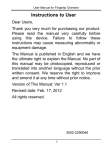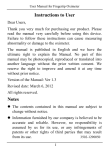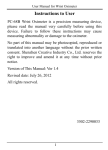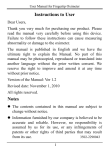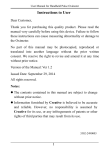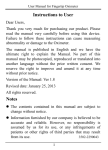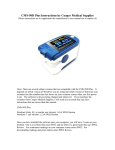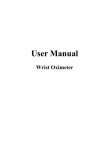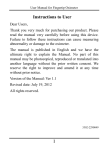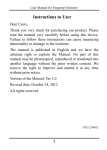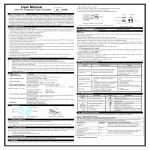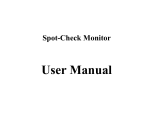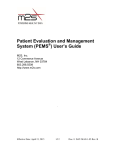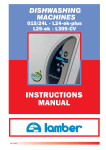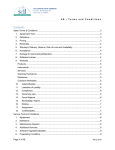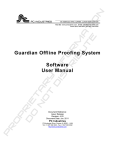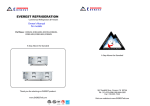Download Pulse Oximeter User Manual
Transcript
Pulse Oximeter Portable Monitoring Device User Manual Model: PC-60D2 TABLE OF CONTENTS 1 Overview..............................................................................1 1.1 Appearance....................................................................1 1.2 Name and Model............................................................2 1.3 Intended Use..................................................................2 1.4 Feature List....................................................................2 1.5 Important Acroynms.....................................................2 2 Battery Installation..............................................................3 3 Quick Guide to Operation...................................................4 4 Display Screen.....................................................................5 5 Instructions for Operation..................................................7 6 Technical Specifications.....................................................8 7 Alarms..................................................................................9 8 Classifications...................................................................10 9 Accessories.......................................................................10 10 Repair and Maintenance.................................................11 10.1 Maintenance..............................................................11 10.2 Cleaning and Disinfecting........................................11 11 Troubleshooting...............................................................13 Appendix...............................................................................14 A. Key of Symbols.............................................................14 B. Common Knowledge....................................................15 C. Notes..............................................................................17 D. Cautions........................................................................18 E. Warnings........................................................................19 OVERVIEW 1.1 Appearance Rubber Cushions Display Key Display Screen Figure 1: Front View Nameplate Battery Cover Hanging Hole Figure 2: Back View 1 1.2 Name and Model Name: Pulse Oximeter Model: PC-60D2 1.3 Intended Use This Oximeter is intended for measuring the pulse rate and functional oxygen saturation (SpO2) through user’s finger. It is solely for use of spot-checking the pulse rate and SpO2 in the environment including exercise, high altitude sport and aviation activity. 1.4 Feature List • Dual Color LCD with Backlight • Measures SpO2 & Pulse Rate • Displays Waveform & Perfusion Index • Auto On/Off • Alarm • Low Voltage Indicator • Multi-Directional Display 1.5 Important Acronyms • SpO2: Pulse Oxygen Saturation • BPM: Beats Per Minute • PR: Pulse Rate • PI: Perfusion Index 2 2 Battery Installation 2 1 Figure 3: Battery Installation Step 1: (Refer to Figure 3) Insert two (2) AAA size batteries into the battery compartment. Step 2: Slide the battery cover into place. Note: To ensure the device works properly, please make sure the batteries are installed correctly. 3 3 Quick Guide to Operation Step 1: Open the clip and put finger into the rubber cushions of the clip (make sure the finger is in the correct position), and then clip the finger. Step 2: Wait about 2 seconds, the oximeter will power on automatically and start to measure. To change the display direction by 180 degrees, press the button. Display direction change shows bar-graph, pulse rate symbol and waveform. Press the button again to flip the display back. (see figures 5 & 7) To shift the displayed readings between PR and PI, press and hold the button. (see figures 6 & 7) Step 3: Remove your finger, the oximeter will power off automatically. 4 4 Display Screen For PC -60D2 oximeter, SpO2 and PR symbols are imprinted on the front panel and its corresponding value displays on display screen below the symbol. (see figure 4) Note : the two figures both show that SpO2 value is 99% and PR value is 86bpm. PR SpO2 Pulse Bar Waveform Figure 4 Figure 5 Note : the two figures both show that SpO2 value is 99% and PI value is 7.5%. PI SpO2 Pulse Bar Waveform Figure 6 Figure 7 5 Waveform Display The waveform on the pulse oximeter is the plethysmogram which helps to understand if the readings are reliable. Normally, a smooth and regular waveform would represent good signal quality and therefore a more reliable reading. In comparison, an unsmooth or irregular waveform would represent poor signal quality with motion artifact and therefore would produce readings that may be inaccurate or unreliable. PI Display Perfusion Index (PI) indicates the bloodflow perfusion under the measuring site and also represents the pulse strength for determination of SpO2 and PR. It is recommended to select a measuring site with a higher PI value, such as a fingertip, to obtain higher pulse strength. The pulse oximeter may reach the declared accuracy while the PI value is as low as 0.6%. 6 5 Instructions for Operation • The finger should be put in properly and correctly. • Do not shake the finger. Keep at ease during measurement. • Do not put wet finger directly into sensor. • Avoid placing the device on the same limb which is wrapped with a cuff for blood pressure measurement or during venous infusion. • Do not let anything block the emitting light from device. • Vigorous exercise or strong electro-magnetic interference may affect the measuring accuracy. • Using enamel or other makeup on the fingernail may affect the accuracy of measurement. • If the first reading has irregular or unsmooth waveforms, then it is likely inaccurate. A more reliable reading may be achieved by waiting for a short period of time or restarting the device. 7 6 Technical Specifications Net Weight 60g (including batteries) Dimensions 66 mm (L) × 36 mm (W) × 33 mm (H) Power Supply 2 x LR03 (AAA) Akaline Batteries Transducer Dual-wavelength LED sensor Wavelength: Red Light: 663nm, Infrared light: 890nm SpO2 Measurement Range 35-99% SpO2 Measuring Accuracy1 Not greater than 3% for SpO2 range from 70-100% Pulse Rate (PR) Measurement Range 30bpm-240bpm Pulse Rate Accuracy ±2bpm or ±2% (whichever is greater) Perfusion Index (PI) Display Range2 0-20% Operating Temp 5°C to 40°C Operating Humidity 30% to 80% Operating Altitude up to 4,000 meters Warranty 2 years Accuracy defined as root-mean-square value of deviation according to ISO 9919. 1 Performance Under Low PI Condition - The accuracy of the SpO2 and PR measurement still meet the precision described above when the PI is as low as 0.6%. 2 8 7 Alarms Preset Alarm Limits SPO2 alarm: Lower limit: 90% PR alarm: Upper limit: 120bpm Lower limit: 50bpm Audible & Visual Alarm Function During measurement, if the SpO2 value or PR value exceeds the preset alarm limit, the device will alarm automatically and the value which exceeds the limit will flash on the screen while the buzzer beeps. 9 8 Classifications Protection against electric shock: Internally powered equipment. Degree of protection against electric shock: Type BF applied parts. Degree of protection against harmful entrance of liquids: Ordinary equipment without protection against entrance of water. Electro-Magnetic Compatibility: Group I, Class B 9 Accessories • Lanyard • Two (2) AAA batteries • Carrying pouch • User Manual • Quality Certificate Note: The accessories are subject to change. Detailed items and quantity see the packing list. Additional accessories may be purchased by contacting Quest Products, Inc. at 847.693.2740 or [email protected]. 10 10 Repair and Maintenance 10.1 Maintenance The service life (not a warranty) of this device is 5 years. In order to ensure its long service life, please pay attention to the maintenance. • Change the batteries when the low-voltage indicator lights up. • Clean the surface of the device before using. Wipe the device with wet cloth first, and then let it air dry or wipe it dry. • Remove the batteries if the oximeter will not be used for a long time. • The recommended storage environment of the device: Ambient temperature: -20ºC ~60ºC, relative humidity 10%~95%, atmospheric pressure: 50kPa~107.4kPa. • The oximeter is calibrated in the factory before sale, there is no need to calibrate it during its life cycle. However, if it is necessary to verify its accuracy routinely, the user can conduct the verification by means of a SpO2 simulator, or it can be done by a local third party tester (see page 20). 11 10.2 Cleaning and Disinfecting Instruction • Surface-clean sensor (on upper and lower rubber cushions within the finger clip) with a soft cloth by wetting with a solution such as 75% isopropyl alcohol then surface-clean with a cloth saturated with clean water and dry with a clean, soft cloth. Caution: • Do not sterilize by irradiation or steaming method • Do not use the device if it is damaged. High-pressure sterilization or disinfection cannot be used on the device. Do not immerse the device in liquid. It is recommended that the device should be kept in a dry environment. Humidity may reduce the life of the device, or even damage it. 12 11 Troubleshooting Trouble Possible Reason Solution SpO2 and PR display instable 1. The finger is not placed far enough inside. 2. The finger is shaking or the user is moving. 1. Place the finger correctly inside and try again. 2. Calm the user. Device will not turn on 1. The batteries are drained or almost drained. 2. The batteries are not inserted properly. 3. The device is malfunctioning. 1. Change batteries. 2. Reinstall batteries. 3. Contact service provider (see page 19) No display 1. The device will power off automatically when it gets no signal for 8 seconds. 2. The batteries are almost drained. 1. Normal. 2. Change batteries. 13 Appendix A. Key of Symbols Symbol %SpO2 Description Pulse oxygen saturation Pulse rate (beats per minute) PI% Perfusion Index (%) Pulse intensity bargraph Low battery voltage SN Serial number Date of manufacture With Type BF applied part Warning ─ See User Manual Disposal of this device according to WEEE regulations 14 Appendix B. Common Knowledge Meaning of SpO2 SpO2 is the saturation percentage of oxygen in the blood, so called O2 concentration in the blood; it is defined by the percentage of oxyhemoglobin (HbO2) in the total hemoglobin of the arterial blood. SpO2 is an important physiological parameter to reflect the respiration function; it is calculated by the following method: SpO2 = HbO2/ (HbO2 +Hb)×100% HbO2 are the oxyhemoglobins (oxygenized hemoglobin), Hb are those hemoglobins which release oxygen. Meaning of PI Perfusion Index or PI is the ratio of the pulsatile blood flow to the non-pulsatile static blood flow in a patient’s peripheral tissue, such as finger tip, toe, or ear lobe. Perfusion index is an indication of the pulse strength at the sensor site. The PI’s values range from 0.2% for very very weak pulse to 20% for extremely strong pulse. The perfusion index varies depending on patients, physiological conditions, and monitoring sites. Because of this variability, each patient should establish his own “normal” perfusion index for a given location and use this for monitoring purposes. PI is also a good indicator of the reliability of the pulse 15 oximeter reading. For most pulse oximeters for general use, the reading is unreliable or unavailable if PI is at or below 0.4%. Principle of Measurement Based on Lamber-Beer law, the light absorbance of a given substance is directly proportional with its density or concentration. When the light with certain wavelength emits on human tissue, the measured intensity of light after absorption, reflecting and attenuation in tissue can reflect the structure character of the tissue by which the light passes. Due to that oxygenated hemoglobin (HbO2) and deoxygenated hemoglobin (Hb) have different absorption character in the spectrum range from red to infrared light (600nm~1000nm wavelength), by using these characteristics, SpO2 can be determined. SpO2 measured by this oximeter is the functional oxygen saturation -- a percentage of the hemoglobin that can transport oxygen. In contrast, hemoximeters report fractional oxygen saturation – a percentage of all measured hemoglobin, including dysfunctional hemoglobin, such as carboxyhemoglobin or metahemoglobin. Practical application of oximeters Pulse Rate and SpO2 level are important physiological parameters to review the reaction of body during physical activity, so instant spot-checking pulse rate and SpO2 by an oximeter is a popular solution in any environment including exercise, high altitude sport and 16 air travel. The medical precondition can be monitored in a timely manner by the measurement of PR & SpO2, it will allow finding the hypoxia status earlier, thereby preventing or reducing the risk of occurance of hypoxemia effectively. Factors affecting SpO2 measuring accuracy • Intravascular dyes such as indocyanine green or methylene blue • Exposure to excessive illumination, such as surgical lamps, bilirubin lamps, fluorescent lights, infrared heating lamps, or direct sunlight • Vascular dyes or external used color-up product such as nail enamel or color skin care • Excessive user movement • Placement of a sensor on an extremity with a blood pressure cuff, arterial catheter, or intravascular line • Exposure to the chamber with High pressure oxygen • There is an arterial occlusion proximal to the sensor • Blood vessel contraction caused by peripheral vessel hyperkinesias or body temperature decreasing 17 Appendix C. Notes • The contents contained in this manual are subject to change without notice. • Information furnished by our company is believed to be accurate and reliable. However, no responsibility is assumed by us for its use, or any infringements of patents or other rights of third parties that may result from its use. Instructions for Safe Operations • Check the device to make sure that there is no visible damage that may affect user’s safety or measurement performance with regard to sensors and clips. It is recommended that the device should be inspected minimally once a week. When there is obvious damage, stop using the device. • Necessary maintenance must be performed only by qualified service technicians. Users are not permitted to maintain it by themselves. (see page 20) • The oximeter cannot be used together with devices not specified in User Manual. D. Cautions • Explosive hazard—DO NOT use the oximeter in environment with inflammable gas such as some ignitable anesthetic agents. • DO NOT use the oximeter while the testee is under MRI or CT scanning. 18 E. Warnings • An uncomfortable or painful feeling may appear if using the oximeter continuously on the same place for a long time, especially for poor microcirculation users . It is recommended that the oximeter should not be applied to the same location for longer than 2 hours. If any abnormal condition is found, please change the position of oximeter. • DO NOT clip this device on edema or tender tissue. • The light (the infrared light is invisible) emitted from the device is harmful to the eyes, so service technician or testee should not stare at the light. • The local law must be followed when disposing of the device. Attentions • Keep the oximeter away from dust, vibration, corrosive substances, explosive materials, high temperature and moisture. •The device should be kept out of the reach of children. • If the oximeter gets wet, please stop using it and do not resume operation until it is dry. When it is carried from a cold environment to a warm and humid environment, please do not use it immediately. • DO NOT operate the button on the front panel with sharp materials. 19 • DO NOT use high temperature or high pressure steam disinfection on the oximeter. Refer to Section 8 for instructions on cleaning and disinfection. Declaration of Conformity The manufacturer hereby declares that this device complies with the following standards: IEC 60601-1 ISO 9919 For servicing or product related questions, please contact: Quest Products, Inc. 191 Ambrogio Drive Gurnee, IL 60031 USA Tel: 847.693.2740 [email protected] www.questproductsinc.com 20 Quest Products, Inc. 191 Ambrogio Drive Gurnee, IL 60031 USA Tel: 847-693-2740 www.questproductsinc.com
























